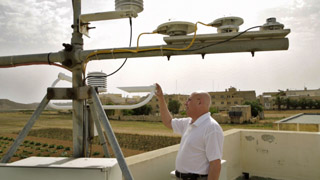An ERDF-funded project that monitors levels of volcanic ash between Italy and Malta is making the skies over the central Mediterranean Sea safer for aircrafts.
Vamos Seguro makes the skies safer
- 09 May 2014
Volcanic ash in the atmosphere causes pollution, effects ecosystems, human health, the climate and, in the worst case, can cause aircraft engines to fail. The silicate particles and gases released during volcanic eruptions also damage crops and road.
Over the past two decades Mount Etna, on the Italian Island of Sicily, has become increasingly active. It is currently Europe’s most active volcano and, indeed, one of the world’s most active volcanoes. During its frequent eruptions, volcanic plumes rise up several kilometres above the summit craters and volcanic ash plumes sometimes reach Malta, some 100 km south of Sicily.
To monitor and forecast volcanic ash plumes produced during Etna’s eruptions, a cross-border project between Italy and Malta has led to the installation of an automatic detection system on the islands of Sicily and Malta.
Hi-tech equipment
The VAMOS SEGURO project saw the installation of new detection instruments at the University of Malta’s observatory facilities on the islands of Malta and Gozo. In Sicily, an innovative LIDAR system will be operated from two sites: Montedoro in the centre of Sicily and the Serra La Nave observatory of the Istituto Nazionale di Astrofisica in Catania.
This so-called LIDAR sensing system uses a laser to measure distances by analysing reflected light and is able to precisely estimate the column height and produce a map of volcanic plumes.
The system detects dangerous concentrations of volcanic ash in the skies between Sicily and Malta and, together with the volcanic plume dispersal forecasts, may be used to alert airlines and to inform decisions on the closure of those areas to aircraft.
“The project is very helpful for people that, during explosive eruptions, walk up to the summit craters to observe the spectacular show that Etna provides because they can know the main dispersal of the volcanic plume and, consequently, where lapilli and ash will fall down. Moreover, data acquired from the VAMOS SEGURO project is available to civil and aviation authorities that, during these eruptions, have to take important decisions for improving the safety of people.”
Simona Scollo, co-ordinator of the VAMOS SEGURO project
Total investment and EU funding
The “VAMOS SEGURO [Volcanic Ash Monitoring and fOrecaSting between Sicily and Malta arEa and sharinG of the resUlts foR aviatiOn safety]” project had a total budget EUR 837 884, to which the European Regional Development Fund contributed EUR 498 499 from the cross-border Operational Programme Italy-Malta for the 2007 to 2013 programming period.

